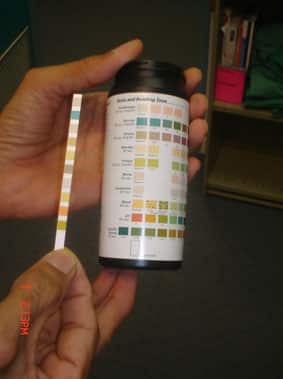Sample B indicates diabetes mellitus. Diabetes mellitus is caused by inadequate secretion of insulin from islet cells in the pancreas, which causes sugar levels to rise. People suffering from this disease will have higher blood sugar concentrations which remain in the nephrons and this is detected in their urine. This correlates with sample B result which tested positive in Benedict’s test with +2.0% sugar levels (red to red-brown).
Sample E indicates diabetes insipidus. Diabetes insipidus is caused by the destruction of the ADH- producing cell of the hypothalamus or nerve tract leading from the hypothalamus to the pituitary gland.
They cannot regulate water reabsorption and can void large quantities of dilute urine creating extreme thirst. Therefore a person suffering from this disease will drink large quantities of water and have very diluted urine, similar to the appearance of water.
Sample C indicates Bright’s disease. Bright’s disease is caused by an inflammation of the nephrons. Specifically, the destruction of tiny blood vessels in the nephron causes an altercation in the permeability of the nephrons.
Since there is no mechanism to regulate protein reabsorption, proteins remain the nephrons that draw in large quantities of urine that are eventually voided. The urine sample will appear cloudily, possibly contain visible precipitate, and will test positive for albumin protein; which sample C did.
Sample D indicated an individual who has lost tremendous amounts of water while exercising. It is a concentrated dark yellow urine sample that indicated a lack of water, which would normally dilute the urea, dissolved salts, and organic compounds also found in our urine.
Treatment for Diabetes Mellitus
The primary treatment is to keep glucose levels in the blood as close to normal as safely possible. As a result of their disease, suffers from diabetes mellitus have a greater risk of heart disease and a way to control blood pressure/ cholesterol levels are essential to their treatment plan as well.
Day to day care is required for this disease which includes monitoring blood glucose levels, dietary management, maintaining physical activity, keeping weight and stress under control, monitoring oral medications and, if required, insulin use via injections or pump. A change in dietary habits and augmentation of exercise and usually the first steps toward reducing blood sugar levels.
Also, People suffering from type 1 Diabetes Mellitus require multiple insulin injections on a daily basis to maintain safe insulin levels. Even with type two Diabetes Mellitus insulin is often required. An insulin pump delivers the insult through a catheter into the abdomen to maintain safe levels of insulin. If blood sugar levels remain high even when utilizing the methods stated earlier, oral medication can be provided to reduce blood sugar production.
Treatment for Diabetes Insipidus
Diabetes Insipidus is usually treated with Desmopressin which is a synthetic replacement for vasopressin, the hormone that reduces urine production. This may be taken as a nasal spray several times a day, to maintain normal urine output. However, taking too much of this medication can cause fluid retention and swelling, and other problems.
Sometimes diabetes insipidus can be controlled with drugs that stimulate the production of antidiuretic hormone such as chlorpropamide, carbamazepine, clofibrate. Also suffers must be sure to control fluid balance and prevent dehydration as well as check their weight daily and maintain a record.
Bright’s disease is so difficult to treat because it isn’t necessarily one particular disease but a broad range of kidney disorders that are characterized by the inflammation of the nephrons. For this reason, it is extremely difficult, if not impossible to correctly diagnosis the particular pathogen(s) causing the problem and treat them.
Bright’s disease is often not referred to as a specific disease, but rather multiple problems with the kidney(s) that leads to certain symptoms: back pain, vomiting, fever, smokey/bloody urine. Home remedies for treating acute cases of Bright’s disease include local depletion, bathing in warm water, diuretics, and laxatives. However, there is currently no successful treatment for chronic Bright’s disease; dietary modification can be helpful.
Bibliography
Wolf G (2002). “Friedrich Theodor von Frerichs (1819-1885) and Bright’s disease”. American journal of nephrology 22 (5-6): 596–602. <http://content.karger.com/produktedb/produkte.asp?typ=fulltext&file=ajn22596>
Beam, J. “What Does Bright’s Disease Refer To?.” WiskGeek (2004): 1. Web. 2 May 2010. <http://www.wisegeek.com/what-does-brights-disease-refer-to.htm>.
“Diabetes Insipidus Treatment.” National Institute of Health (2007): 1. Web. 2 May 2010. <http://chinese-school.netfirms.com/diabetes-insipidus-treatment.html>.
American Diabetes Association. Standards of medical care in diabetes — 2008. Diabetes Care. 2009; 32:S13-S61, 2009.
Zieve, David . “Diabetes.” Harvard Medical School (2009): 1. Web. 2 May 2010. <http://www.nlm.nih.gov/medlineplus/ency/article/001214.htm>.


1 Comment